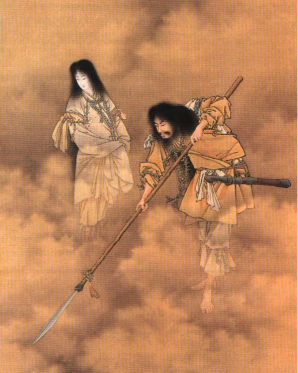Kumano 熊野 is an area located around the Southern tip of the Kii Peninsula spanning between the Wakayama and Mie prefectures. Officially registered as a world heritage site in 2004, Kumano is considered to be one of Japan’s most important and historical religious locations renowned for its numerous pilgrimage routes. Some of which have existed for over a millennium and remain popular even today.
Below is a simple map indicating the location of Kumano (Kumano Sanzan) as well as the popular pilgrimage routes.

Kumano first appears in Japanese literature in 720 in the Nihon Shoki 日本書紀; one of Japan’s oldest books of classical Japanese history. Featuring both mythological and historical elements, Kumano is described as the tomb of the goddess of creation, Izanami.

Evidently, even in ancient times, Kumano was always regarded as an area of spiritual and religious importance and as Moerman describes, often related to death as well. Further exemplifying these two aspects is a tale from the Nihon ryōiki 日本霊異記; Japan’s oldest collection of Buddhist setsuwa, which tells the story of an ascetic who continued to recite the Lotus Sutra in the mountains of Kumano even after his death.
The Kumano pilgrimage is also featured in other popular literary works such as the famous Dōjōji monogatari. A story about Anchin, a young monk who encounters a lustful woman during his trip to Kumano. He deceives the woman by telling her he’ll return after his pilgrimage is done but instead chooses a different route to avoid her. This causes the woman to go into a rage and transform into a serpent. Chasing down the monk until he meets his demise at Dōjōji, a famous temple located south of Kumano. The story of Dōjōji exists in various different books and collections and is a staple of both noh and kabuki theatre. While many version of the tale only briefly describe Anchin’s pilgrimage, more illustrious depictions such as the one found in Muromachi jidai monogatari taisei, features a much more in depth description of the paths Anchin took, the locations he visited as well as poems and myths that relates to particular locations. In this version, Kumano is described in the following passage translated by Skord.
“He arrived at the shine complex and read sutras to gratify the gods. Kumano surpassed his every expectation, and he marveled at all he saw. That night, he kept vigil in the Purification Hall, praying for enlightenment and deliverance from the cycle of birth and death. As the night deepened, even the shadows of the hall seemed to be suffused with holiness, and his heart was cleansed.” (141-143)
Once again, we see Kumano portrayed as a location of spiritual and religious significance. The woman’s transformation into a serpent and Anchin’s death in Dōjōji, while not directly situated in Kumano is located very close by and can also be related to the elements of mythology and death discussed earlier.

Lastly, I’ve included some pictures from Kumano’s famous three grand shrines – Hongu, Hayatama and Nachi:
Works Cited
Moerman, David Leo. Localizing Paradise: Kumano Pilgrimage in medieval Japan. Stanford University, ProQuest Dissertations Publishing, 2000. Web.
Skord, Virginia. Tales of Tears and Laughter: Short Fiction of Medieval Japan. Honolulu: University of Hawaii Press, 1991. Web.
Image Sources
http://www.tb-kumano.jp/en/world-heritage/kumano_sanzan/
https://en.wikipedia.org/wiki/Izanami-no-Mikoto
https://alljapantours.com/go-attrcont.php?cid=2&sid=2&p=AN112177979
http://www.kumano-travel.com/index/en/action_ModelCourseDetail_Detail/id61
Contributor: Henry Hsu
(Edited by Elle Marsh)

You must be logged in to post a comment.